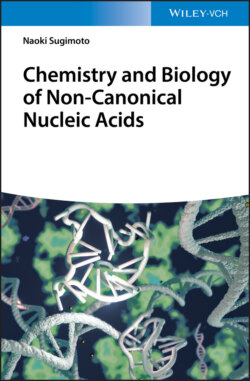Читать книгу Chemistry and Biology of Non-canonical Nucleic Acids - Naoki Sugimoto - Страница 31
2.6.2.1 Hairpin Loop
ОглавлениеHairpin loop, which is also designated as stem loop, is formed when sequence of RNA has complementary regions at 5′ and 3′ regions. The complementary regions form duplex, and the region in between remains as single-stranded loop. It is an essential secondary structure element not only for interaction of proteins but also for further formation of complexed tertiary structures of RNA. RNA transcripts from the DNA regions, which potentially form cruciform, likely form the hairpin structure. Stability of RNA hairpin depends on the length of loop size. Stability decreases with increasing loop length, and four or five nucleotides in the loop form the most stable hairpin [14]. Closing base pair, which is a base pair located at the boundary between the stem and loop region, also affects the stability. G·C and C·G base pairs are preferred to make stable and robust hairpin structures [15]. Some specific loop sequence, which is typified by UNCG, in which N is any nucleobase, can drastically stabilize the loop region [16]. For example, 5′-UUCG-3′ loop with C·G closing base pair forms one of the most stable hairpin loops, which can be often seen in natural RNAs [17]. NMR structure of 5′-GGACUUCGGUCC-3′ demonstrated that the hairpin loop structure is stabilized by unusual base pairing between uracil and guanine in the loop, in which glycosidic bond angle of guanine is in syn conformation. The structure is also stabilized by a cytosine-phosphate contact and extensive base stacking on the crossing base pair (Figure 2.8) [18].
